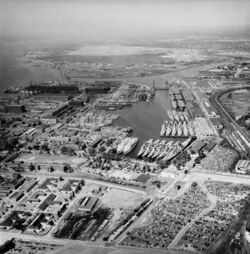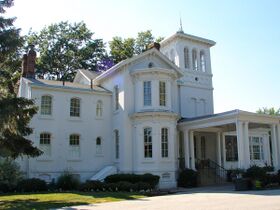Company:Philadelphia Naval Shipyard
| The Navy Yard, Philadelphia, PA | |
|---|---|
| Philadelphia, Pennsylvania | |
 Reserve Fleet in Philadelphia in 1955 | |
| Type | Shipyard |
| Site information | |
| Controlled by | United States Navy |
| Site history | |
| Built | 1917 (League Island Facility) |
| In use | 1801–1995 |
| Battles/wars | |
Philadelphia Naval Shipyard Historic District | |
| Lua error in Module:Location_map at line 522: Unable to find the specified location map definition: "Module:Location map/data/Pennsylvania" does not exist. | |
| Location | S. Broad St. Philadelphia, Pennsylvania |
| Coordinates | [ ⚑ ] : 39°53′28″N 75°10′43″W / 39.89111°N 75.17861°W |
| Area | 1,200 acres (490 ha) |
| Built | 1876 |
| Architect | Robert E. Peary; Karcher & Smith |
| Architectural style | Modern Movement, Late Victorian |
| NRHP reference # | 99001579[1] |
| Added to NRHP | 22 December 1999 |
Commandant's Quarters | |
 | |
| Location | Philadelphia, Pennsylvania |
| Built | 1874 |
| Architect | US Department of the Navy |
| Architectural style | Italian Villa |
| NRHP reference # | 76001661[1] |
| Added to NRHP | 3 June 1976 |
The Navy Yard, formerly known as the Philadelphia Naval Shipyard and Philadelphia Naval Business Center, was an important naval shipyard of the United States for almost two centuries.[2] It is now a large industrial park that includes a commercial shipyard, Philly Shipyard.
Philadelphia's original navy yard, begun in 1776 on Front Street and Federal Street in what is now the Pennsport section of the city, was the first naval shipyard of the United States. The new, much larger yard grew up around facilities begun in 1871 on League Island at the confluence of the Delaware and Schuylkill Rivers.
The United States Navy ended most of its activities there in the 1990s; subsequently, in 2000, the city of Philadelphia took over and began to redevelop the land. The Navy still has a Naval Inactive Ship Maintenance Facility and a few engineering activities at the site.
History
The yard has its origins in a shipyard on Philadelphia's Front Street on the Delaware River that was founded in 1776 and became an official United States Navy site in 1801. From 1812 till 1865 it was a big production center. The first ship which was launched to the water was the USS Franklin. This event was watched by more than 50,000 spectators. The rapid development of other shipbuilding companies pledged Philadelphia to improve production processes. It was the first shipyard in the world which used floating dry docks in the building process to improve an operating time of the ships.[3] After the advent of ironclad warships made the site obsolete, new facilities were built in 1871 on League Island at the confluence of the Delaware and Schuylkill Rivers.[citation needed]
From early in the nineteenth century many Philadelphia workers agitated for a reduction in the arduous twelve hour workday. The workday in the Philadelphia Navy Yard prior to 1835 was sunrise to sunset, with time off for breakfast. In the summer of 1835 Philadelphia Navy Yard shipwrights, joiners and other workers became leaders in this effort when they chose to combine direct action, a strike, with political pressure to the executive branch. After first making a request to the Secretary of the Navy via shipyard Commandant Commodore James Barron, on 29 August 1835 they appealed directly to President Andrew Jackson. Commodore Barron endorsed his workers request with the following acknowledgment "I would respectfully observe – Seems to be inevitable, sooner or later, for as the working man are seconded by all the Master workmen, city councils etc. there is no probability they will secede from their demands."[1]
Their petition was granted and on 31 August 1835 the president ordered the Secretary of the Navy to grant the ten hour work day effective 3 September 1835. However, the change was only applicable to the Philadelphia Navy Yard. It was another 5 years before the ten hour day was extended to all government employees engaged in manual labor; this was accomplished via an executive order by President Martin Van Buren on 31 March 1840.[4]
The Naval Aircraft Factory was established at the League Island site in 1917. Just after World War I, a 350-ton capacity hammerhead crane was ordered for the yard. Manufactured in 1919 by the McMyler-Interstate Company in Bedford, Ohio, the crane was called the League Island Crane by its builder. Weighing 3,500 tons, the crane was shipped to the yard in sections, and it was the world's largest crane at the time.[5] The "League Island Crane" was for many years the Navy's largest crane.[citation needed]
Mustin Field opened at the Naval Aircraft Factory in 1926 and operated until 1963.[citation needed]
The shipyard's greatest period came in World War II, when the yard employed 40,000 people who built 53 ships and repaired 574. During this period, the yard built the famed battleship New Jersey and its 45,000-ton sister ship, Wisconsin. In the Naval Laboratory, Philip Abelson developed the liquid thermal diffusion technique for separating uranium-235 for the Manhattan Project.[6]
After the war, the workforce dropped to 12,000, and in the 1960s, new ships began to be contracted out to private companies. The yard built its last new ship, the command ship Blue Ridge, in 1970.[citation needed]

The yard's closure was originally recommended in 1991 by the Base Realignment and Closure Commission, as a result of foreign competition and reduced needs due to the end of the Cold War. The planned closing was unsuccessfully litigated to the US Supreme Court in Dalton v. Specter. Although local politicians tried to keep the yard open, it finally closed in 1995 with a loss of 7,000 jobs. Senator Arlen Specter charged that the Department of Defense did not disclose the official report on the closing. This resulted in a controversy that led to further legal disputes, to no avail. Since its transfer from the government, the west end of property has been leased to Aker Kværner, a tanker and commercial shipbuilding firm.[citation needed]
The City of Philadelphia became the landlord and owner of The Navy Yard in March 2000, when the Philadelphia Authority for Industrial Development (PAID) took title to roughly 1,000 acres from The Navy. Currently, the Philadelphia Industrial Development Corporation (PIDC) manages the planning, operation, and development of The Navy Yard on behalf of PAID and the City of Philadelphia. A comprehensive master plan was developed in 2004 to turn the former industrial yard to a mixed-use campus.[citation needed]
As of 2010, navy activities there include Naval Support Activity Philadelphia, the Naval Surface Warfare Center Ship Systems Engineering Station, Naval Facilities Engineering Command Mid-Atlantic Public Works Department Pennsylvania (NAVFAC MIDLANT PWD PA) and the Naval Inactive Ship Maintenance Facility (NISMF), which stores decommissioned and mothballed warships and auxiliary naval vessels.[citation needed]
The Navy Yard is home to 120 companies with 10,000 employees, as the campus continues to expand and develop. Clothing manufacturer Urban Outfitters consolidated its Philadelphia headquarters on the site, while Tasty Baking Company, makers of Tastykakes, has moved their bakery to the 26th Street side of The Yard. Other companies there include Rittenhouse Ventures, GlaxoSmithKline, Iroko Pharmaceuticals, Aker Philadelphia Shipyard, Rhoads Industries, Philadelphia Industrial Development Corporation (PIDC), Energy Efficient Buildings Hub (EEB Hub), RevZilla.com, and Mark Group, Inc.[citation needed]
In January 2013, company announced about increasing the number of apartments for employees (near 1,000) and infrastructure development. This is made possible by the public financing of shipyards and investments of private companies. According to the plan for 2013 the number of employees at the shipyard amount to around 30,000 people.[7]
In March 2013, the Canadian Pacific – Bulkmatic Transport transload site on Langley Ave was closed.
In April 2013, pharmaceutical giant GlaxoSmithKline opened a 205,000-square-foot building in The Navy Yard's Corporate Center.[8]
The memorial chapel to the Four Chaplains also sits on the grounds.[9]
The Athletic Base Ball Club of Philadelphia hosts the annual Philadelphia Base Ball Fair & Exhibition on the Navy Yard Marine Parade Grounds.[citation needed]
Notable ships
- New Jersey
- Wisconsin: Last keel laid for a completed battleship of the United States Navy, 25 January 1941[10]
- The final ships built were LST-1179, LST-1180 and LST-1181 starting in 1969 and completed in early 1971.[citation needed]
See also
- League Island
- Commandant's Quarters (Philadelphia, Pennsylvania)
- Marine Barracks (Philadelphia, Pennsylvania)
Notes
- ↑ 1.0 1.1 "National Register Information System". National Register of Historic Places. National Park Service. January 23, 2007. https://npgallery.nps.gov/NRHP.
- ↑ http://www.philly-yardbird.com/
- ↑ "The Navy Yard Philadelphia". http://www.navyyard.org/about-the-campus/history. Retrieved 8 July 2016.
- ↑ Roediger, David R; Foner, Phillip Sheldon (1989). Our Own Time: A History of American Labor and the Working Day. London: Verso. pp. 39–41. ISBN 0860919633.
- ↑ "McMyler-Interstate Co.." Bedford Historical Society. N.p., n.d. Web. 19 June 2010. <http://www.bedfordohiohistory.org/build/mcmyler.php>.
- ↑ "Resource Letter MP-2: The Manhattan project and related nuclear research". American Journal of Physics 79 (2): 151–163. 24 January 2011. doi:10.1119/1.3533209. ISSN 0002-9505. http://aapt.scitation.org/doi/10.1119/1.3533209.
- ↑ "Business booms at old naval shipyard in Philadelphia". http://www.foxnews.com/us/2013/02/11/business-booms-at-old-naval-shipyard-in-philadelphia.html. Retrieved 8 July 2016.
- ↑ "The Navy Yard Welcomes: GlaxoSmithKline". The Navy Yard. http://navyyard.org/theyardblog/the-navy-yard-welcomes-glaxosmithkline/. Retrieved 7 October 2013.
- ↑ Grills, Matt (20 January 2015). "More than a story". American Legion Magazine. http://www.legion.org/magazine/225769/more-story. Retrieved 30 March 2016.
- ↑ BB-64 was launched and commissioned before BB-63, in spite of a later keel-laying.[citation needed]
External links
- Historic American Engineering Record (HAER) No. PA-387, "Naval Base Philadelphia-Philadelphia Naval Shipyard"
- Yeoman, Barry (May–June 2001). "Subsidies at Sea". Mother Jones. https://www.motherjones.com/politics/2001/05/subsidies-sea.



